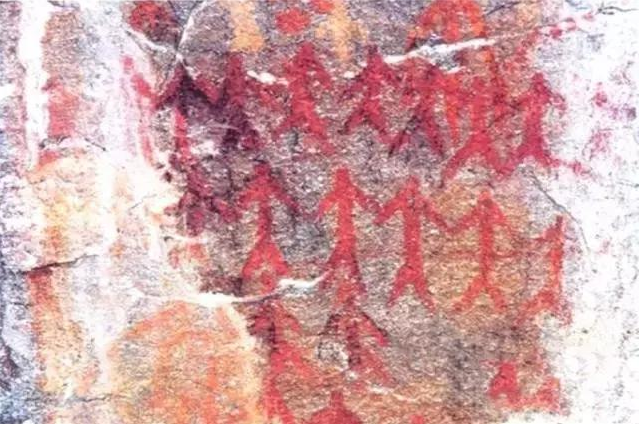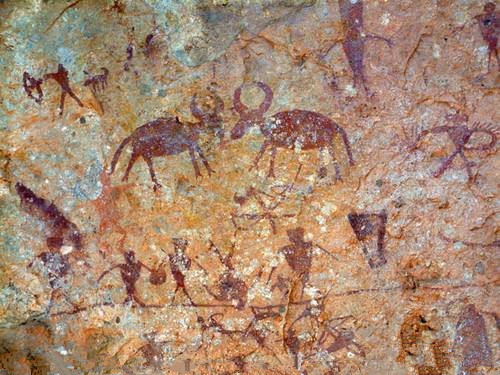The Cangshan Cliff Paintings (苍山崖画) in Yangbi (漾濞) are an ancient cultural heritage site located in Cangshanxi Town (苍山西镇), Yangbi Yi Autonomous County (漾濞彝族自治县), Dali Prefecture (大理州), Yunnan Province (云南省). With a history of over 3,000 years, the paintings were discovered in October 1994. The images depict scenes of cattle, hunting, dancing, and other aspects of life. Covering a total area of 16.5 square meters, it is the largest single rock art panel currently known in Yunnan.
The cliff paintings confirm early human activity on the western slopes of Diancang Mountain (点苍山) and hold significant value for the study of the ancient social, ethnic, and artistic history of the Dali region. Since being designated a provincial-level protected cultural relic in 2003, the site has been preserved through digital imaging technology, and a rescue conservation project was launched in 2023.

- Date Discovered: October 1994
- Protection Level: Provincial-Level Cultural Heritage Site
- Elevation: 2,070 meters
- Site Area: 16.5 square meters
- Location: Chishuiqing (吃水箐) on the mid-slope of Diancang Mountain (点苍山)
- Date Announced: 2003
Discovery and Confirmation
The site was discovered in October 1994, approximately 3 kilometers southeast of Jinniu Village (金牛村) in Cangshanxi Town (苍山西镇). It was confirmed by archaeologists as the only officially recognized ancient cliff painting site in Dali Prefecture (大理州). The paintings are concentrated on a cliff wall at an altitude of 2,070 meters on the mid-slope of Diancang Mountain (点苍山), with recognizable images covering about 60% of the rock surface.
Content and Artistic Features
The images were painted using red mineral pigments and include the following themes:
- Group hunting scenes featuring figures with bows surrounding animals
- Scenes of fruit gathering and herding
- Simple line drawings of houses and bonfire dances
- Robust depictions of wild buffalo and domesticated animals
The largest single figure reaches 2.3 meters in length. Human figures are rendered in abstract geometric shapes, while animals are portrayed with an emphasis on motion, reflecting the artistic characteristics of ancient peoples.
Historical and Research Value

As the most complete group of prehistoric rock paintings remaining in western Yunnan, these works predate the Nanzhao Kingdom (南诏国) and document the survival practices of early tribes in the Cangshan (苍山) region. Scenes showing livestock domestication offer visual evidence for the origins of agriculture in Southwest China. Through pigment analysis, archaeologists have inferred that the paintings were created using a mixture of hematite and animal fat.
Protection and Management
After its designation as a provincial-level protected site in 2003, a regular patrol and monitoring system was established. In January 2023, County Party Secretary Zhang Shiwei (张世伟) led a site visit and emphasized:
- Using rescue-style conservation methods to restore weathered areas
- Establishing a three-tiered accountability system: local government + departments + supervisors
- Inviting institutions such as the Chinese Academy of Social Sciences to carry out scientific assessments
As of 2023, reinforcement work had been completed in 22 key areas, and a 50-meter-radius protective buffer zone had been established.
Digital Preservation
During the digital imaging project implemented in 2022:
- High-precision 3D scanning was used to build digital models
- Dynamic scenes such as buffalo grazing and bonfire lamb roasting were digitally reconstructed
- Four cultural heritage promotional videos were produced
- An interactive holographic exhibition area was installed in the county museum
This technology enabled the digital archiving of 18 endangered images, with visual clarity improved by 40% after restoration.

 7 Days GolfingTour
7 Days GolfingTour
 8 Days Group Tour
8 Days Group Tour
 8 Days Yunnan Tour
8 Days Yunnan Tour
 7 Days Shangri La Hiking
7 Days Shangri La Hiking
 11 Days Yunnan Tour
11 Days Yunnan Tour
 6 Days Yuanyang Terraces
6 Days Yuanyang Terraces
 11 Days Yunnan Tour
11 Days Yunnan Tour
 8 Days South Yunnan
8 Days South Yunnan
 7 Days Tea Tour
7 Days Tea Tour
 8 Days Muslim Tour
8 Days Muslim Tour
 12 Days Self-Driving
12 Days Self-Driving
 4 Days Haba Climbing
4 Days Haba Climbing
 Tiger Leaping Gorge
Tiger Leaping Gorge
 Stone Forest
Stone Forest
 Yunnan-Tibet
Yunnan-Tibet
 Hani Rice Terraces
Hani Rice Terraces
 Kunming
Kunming
 Lijiang
Lijiang
 Shangri-la
Shangri-la
 Dali
Dali
 XishuangBanna
XishuangBanna
 Honghe
Honghe
 Kunming
Kunming
 Lijiang
Lijiang
 Shangri-la
Shangri-la
 Yuanyang Rice Terraces
Yuanyang Rice Terraces
 Nujiang
Nujiang
 XishuangBanna
XishuangBanna
 Spring City Golf
Spring City Golf
 Snow Mountain Golf
Snow Mountain Golf
 Stone Mountain Golf
Stone Mountain Golf
















